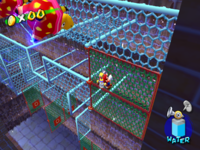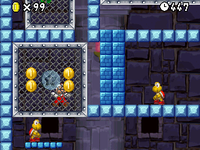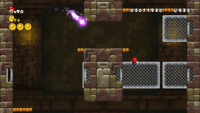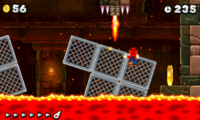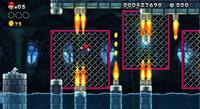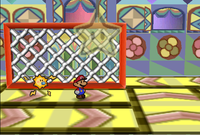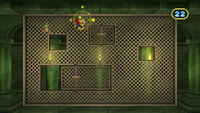Chain-Link: Difference between revisions
LinkTheLefty (talk | contribs) mNo edit summary |
LinkTheLefty (talk | contribs) (Moved from Sunshine article (haven't checked myself yet).) |
||
| Line 77: | Line 77: | ||
*[[Grate]] | *[[Grate]] | ||
==Names in other languages== | ==Additional names== | ||
===Internal names=== | |||
{{internal names | |||
|game1=''[[Super Mario Sunshine]]'' | |||
|file1=<tt>bamboofence_rail</tt><ref>''Super Mario Sunshine'' internal filename (<tt>ObjectData/bamboofence_rail.dae</tt>)</ref> | |||
|name1=bamboo fence rail | |||
|meaning1=bamboo fence | |||
}} | |||
===Names in other languages=== | |||
{{foreign names | {{foreign names | ||
|Jap={{ruby|金網|かなあみ}}<ref>[https://www.nintendo.co.jp/clvs/manuals/ja/pdf/CLV-P-VAAAJ.pdf ''Super Mario World'' Japanese instruction booklet.]</ref><ref>[https://m1.nintendo.net/docvc/NUS/JPN/NSMJ/NSMJ_J.pdf ''Super Mario 64'' Japanese instruction booklet], pages 13 and 19.</ref><ref>''Super Mario Sunshine'' Japanese instruction booklet, page 26.</ref> | |Jap={{ruby|金網|かなあみ}}<ref>[https://www.nintendo.co.jp/clvs/manuals/ja/pdf/CLV-P-VAAAJ.pdf ''Super Mario World'' Japanese instruction booklet.]</ref><ref>[https://m1.nintendo.net/docvc/NUS/JPN/NSMJ/NSMJ_J.pdf ''Super Mario 64'' Japanese instruction booklet], pages 13 and 19.</ref><ref>''Super Mario Sunshine'' Japanese instruction booklet, page 26.</ref> | ||
Revision as of 15:19, May 20, 2023
It has been requested that this article be rewritten and expanded to include more information. Reason: include Wario World information
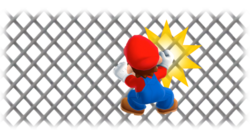
A Chain-Link, also known as a fence, Chain Link Fence,[1] wire net,[2] or metal screen,[3] is an object found in various Mario games. The player character can climb along the surface of the fence and punch it to defeat enemies on the other side. In some games, there are panels that can be used to flip the character to the other side. Similar climbable meshes of vines and other interlocking materials appear in Wario Land 3.
History
Super Mario series
Super Mario World
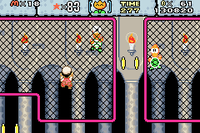
In Super Mario World, fences occasionally appear in castles. Mario or Luigi can jump on, climb on, and jump off fences to go around traps such as lava. The brothers can also flip to the other side by punching a Revolving Door. Climbing Koopas are commonly found to be climbing on fences, and they are capable of climbing around both sides of a fence. The brothers may punch the climbing Koopas that are on the other side to defeat them.
Super Mario 64 / Super Mario 64 DS
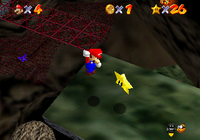
In Super Mario 64 and Super Mario 64 DS, wire nets have different designs depending on the location and have multiple purposes depending on the contexts. Some of them, found primarily in the Hazy Maze Cave, in Bowser in the Fire Sea, and on Tiny-Huge Island, can be climbed, but only horizontally instead of vertically. Others are instead used as walls that only Vanish Mario can get through, which is used more commonly. Sometimes, this is needed to collect a Power Star, while other times (particularly in the remake), it is simply a shortcut (such as in Express Elevator--Hurry Up!). Certain brick walls in Wet-Dry World's downtown work the same way. Sometimes, vertical or block-shaped ones are not found near a Vanish Cap (or Power Flower in the remake) and, as such, are simply used as walls or platforms. This type appears heavily in the Hazy Maze Cave; Dire, Dire Docks; and Tick Tock Clock.
Super Mario Sunshine
In Super Mario Sunshine, metal screens (also referred to as chain-links)[4] can be climbed in both horizontal and vertical orientations. Many of the metal screens take the form of boxes that enclose enemies and coins, although some are traditionally flat. Metal screens appear in Ricco Harbor, Pinna Park, and Pianta Village and can be used to knock off enemies from the other side. The game also introduces Moving Fences.
New Super Mario Bros.
Fences appear again in New Super Mario Bros. in World 3-![]() Tower and World 4-
Tower and World 4-![]() Tower, being the principal feature of both levels.
Tower, being the principal feature of both levels.
New Super Mario Bros. Wii
Fences reappear in New Super Mario Bros. Wii as obstacles in Towers and Castles, similar to Super Mario World. Certain areas are inaccessible unless the player switch to the other side of the fence, via the flip panel. There is also a special type of fence which can be rotated 90 degrees left or right by the first player who climbs the fence by tilting the Wii Remote left or right. Also, a yellow fence is used in the Power-up Panels minigame.
New Super Mario Bros. 2
Fences also appear in New Super Mario Bros. 2, along with other special types of fences introduced in the game. In World 5-![]() Tower, there are large fences made up of smaller fences that move upwards along with the rising lava and, at certain points, rotate. They are required to progress through most of the level. In World 5-Castle, Moving Fences move along a track, and can be changed to move above or below the wire by pressing
Tower, there are large fences made up of smaller fences that move upwards along with the rising lava and, at certain points, rotate. They are required to progress through most of the level. In World 5-Castle, Moving Fences move along a track, and can be changed to move above or below the wire by pressing /
. The flip panels are absent.
New Super Mario Bros. U
Fences appear once again in the Wii U game New Super Mario Bros. U with the same design as in Super Mario World, with red borders instead of gray. Unlike in other games, however, the player can no longer punch on the fences. The flip panels are absent once more.
Super Mario 3D World / Super Mario 3D World + Bowser's Fury
Chain-Links (parsed Chain Links in the Prima guide[5] and Chainlinks in the PAL release) appear in Super Mario 3D World and Super Mario 3D World + Bowser's Fury in several stages as either stationary walls or platforms or moving along tracks as obstacles. In this game, they cannot be climbed on unless the character assumes the Cat form, but can otherwise simply be used to wall jump.
Super Mario Maker 2
Chain-Links with platforms on top of them appear in Super Mario Maker 2 in several themes (except ground, ghost house, and desert) in the Super Mario 3D World style as the style's Semisolid Platforms, all of which Cat Mario can climb up, regardless of theme. Unlike in Super Mario 3D World, they can be climbed indefinitely without falling off.
Super Mario World television series
A small fence makes a brief appearance as an obstacle in Neon Castle in the Super Mario World episode "Mama Luigi". Mario, Luigi and Yoshi are able to easily pass this fence by simply using its revolving gate.
Paper Mario
Wire nets make a brief appearance in Paper Mario, where they are found in a Conveyor Belt-filled segment of Shy Guy's Toy Box and have a similar function to their appearance in Super Mario 64. To get past them, Mario needs to use Lady Bow's Outta Sight ability while on a Conveyor Belt.
Mario Party series
Mario Party 9
In Mario Party 9, a fence appears in the Bowser Jr. minigame Cage Match. Fences are used in the same way as in New Super Mario Bros. Wii.
Mario Party: Island Tour
In Mario Party: Island Tour, fences appear as floor during one segment of Gyro for the Gold.
Super Mario Party
In Super Mario Party, a climbable fence appears prominently in Drop Shot.
Mario Kart series
- Main article: Kanaami Road
Platforms made of Chain-Links, known as Kanaami Roads, appear in some courses in the Mario Kart series, mostly in Mario Kart Tour.
Gallery
Art of Mario punching a Climbing Koopa off the fence from Super Mario World
Vanish Metal Mario standing by wire nets in Dire, Dire Docks in Super Mario 64
A metal screen in Ricco Harbor in Super Mario Sunshine
Vanish Luigi in a cage of wire nets in Tick Tock Clock in Super Mario 64 DS
Chain-Links in Chain-Link Charge in Super Mario 3D World
See also
Additional names
Internal names
| Game | File | Name | Meaning
|
|---|---|---|---|
| Super Mario Sunshine | bamboofence_rail[6] | bamboo fence rail | bamboo fence |
Names in other languages
| Language | Name | Meaning | Notes |
|---|---|---|---|
| Japanese | Kanaami |
Wire Netting | |
| フェンス[10] Fensu |
Fence | ||
| Chinese (simplified) | 铁网[?] Tiěwǎng |
Iron Mesh | |
| Chinese (traditional) | 鋼絲網[11] Gāngsīwǎng |
Steel Wire Mesh | |
| German | Zaun[?] | Fence | |
| Italian | Recinzione Rete metallica Grata[?] |
Fence Wire net Grate |
|
| Korean | 철망[?] Cheolmang |
Wire Netting | |
| Portuguese (NOE) | Cerca Móvel[12] | Mobile Fence | |
| Russian | Сетка[?] Setka |
Fence | |
| Spanish | Valla[?] | Fence |
References
- ^ Nintendo Power Volume 28, page 17.
- ^ Super Mario 64 English instruction booklet, pages 13 and 19.
- ^ Super Mario Sunshine English instruction booklet, page 26.
- ^ Alan Averill and Jennifer Villarreal. Super Mario Sunshine: The Official Nintendo Player's Guide. Redmond: Nintendo of America, 2002. p. 46. ISBN: 1-930206-23-2.[page number needed]
- ^ Musa, Alexander, and Geson Hatchett. Super Mario 3D World PRIMA Official Game Guide. Page 20.
- ^ Super Mario Sunshine internal filename (ObjectData/bamboofence_rail.dae)
- ^ Super Mario World Japanese instruction booklet.
- ^ Super Mario 64 Japanese instruction booklet, pages 13 and 19.
- ^ Super Mario Sunshine Japanese instruction booklet, page 26.
- ^ Shogakukan. 2015. Super Mario Bros. Hyakka: Nintendo Kōshiki Guidebook, Super Mario Sunshine section, page 105.
- ^ Online Chinese manual for New Super Mario Bros. 2. Retrieved March 1, 2020.
- ^ Canal New Super Mario Bros. U (January 11th, 2013). New Super Mario Bros. U - Mar de Menta-CASTELO - Terceira Moeda-Estrela (Wii U) video description.
- Hazardous objects
- Bowser's Fury objects
- Mario Party 9
- New Super Mario Bros. objects
- New Super Mario Bros. 2 objects
- New Super Mario Bros. U objects
- New Super Mario Bros. Wii objects
- Super Mario 3D World objects
- Super Mario 64 objects
- Super Mario Maker 2 objects
- Super Mario Sunshine objects
- Super Mario World objects
